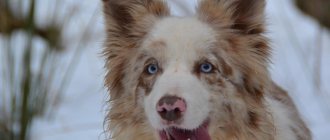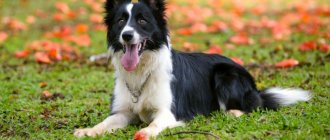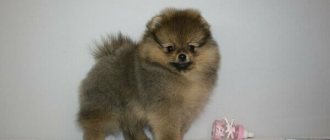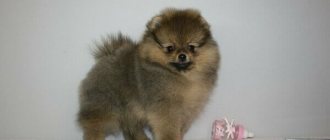The Sheltie subspecies Little Collie was developed in Scotland by crossing a spaniel and a collie.
Sheltie grows small in size, because at first they were bred as an assistant to shepherds.
For more than a century, Shelties were herding dogs and tended flocks.
Now Shelties are decorative dogs; they are happily owned as family pets.
The Sheltie did not take root as a working dog and now the Border Collie is used for working purposes.
The Border Collie is loved by the British. This type of dog predominates in the country. The Sheltie is mostly brown in color, while the Border Collie is black and white.
.
History of the breed
The Sheltie is a fairly young breed. It was only registered at the beginning of the 20th century. The homeland of the mini collie is the Shetland Islands. The ancestors of the breed are several groups of dogs: Norwegian Buhunds, Yakkas, Icelandic Cattle Dogs and Spitz.
Sheltie is a herding breed
Peasants called Shetland Sheepdogs “tiny dog,” which translates as “tiny dog.” These dogs have always been mini collie, that is, a miniature copy of a collie.
The people who stood at the origins of the breed did not care at all what the dog looked like. Man was only concerned about the working qualities of four-legged shepherds. Shelties helped people herd sheep, goats, ponies and birds. Five small shepherd dogs, without human intervention, could drive a flock of sheep from the mountains to the valleys and back. Shelties also protected gardens and haylofts from feral herbivores and birds, scaring them with loud barks. Shetland farmers valued their helpers very much.
The Sheltie gained popularity in the 19th century. Guests of the islands noted the small fluffy dogs that accompanied local farmers everywhere and showed interest in them. Sailors, travelers and traders lined up for Sheltie puppies to bring such an unusual dog home as a gift.
The peasants realized that selling dogs was a good source of income. Breeders began to actively improve the appearance of Shelties by infusing them with the blood of Pomeranians, Papillons and Spaniels. As a result, the Pygmy Collie lines of the time were very different from each other.
For reference! The Sheltie or Little Collie is a breed that only received an approved standard towards the end of the 20th century.
At the same time, breeding work continued. Since some types resembled collies from a distance, breeders decided to enhance the Sheltie's resemblance to these large, fluffy dogs.
During World War I, breeding was suspended and the world almost lost this interesting breed. Fortunately, a few outstanding representatives remained alive, and the breed survived. The Second World War also almost deprived the world of the Sheltie, but everything worked out again.
The Sheltie's popularity increased greatly in 2005, after the release of the film "Lassie" about a collie dog. Those who could not afford to have a large dog opted for a sheltie, a miniature copy of a collie.
Origin
No matter how paradoxical it may sound, it is the different origins that explain both the similarities and differences between these breeds.
The Collie's homeland is on the border of Northern England and Scotland. Initially, it was a herding dog adapted for working needs - strong, squat, with warm, shaggy hair, allowing it to survive outdoors in a rather harsh climate.
Subsequently, breeders worked significantly with the breed, adding the blood of Scottish and Irish Setters, Greyhounds and other breeds. Thanks to them, Collie not only became more resilient, but also acquired an aristocratic appearance.
The Sheltie was also originally a herding dog, the only difference being that it originated from the Shetland Islands. Her ancestors were small dogs similar to Spitz. They owe their modern appearance to crossings with King Charles Spaniels, Spitz, Papillon, Schipperke and Collie.
The Sheltie inherited its appearance from the Scottish Shepherds . Thanks to this, they are so similar in appearance. But other breeds influenced the character and temperament of Shetland Sheepdogs, making them different from Collies.
Description of the breed: main characteristics
Miniature Shepherd (German mini dog)
Mini Sheltie is a very sociable and friendly breed. These dogs get along easily with other animals and are not aggressive at all. This is the kind of dog that barks but never bites. Little collies love training - they are always interested in interacting with people.
Sheltie colors
The only serious disadvantage of the breed is that these dogs cannot tolerate certain medications. This makes Shelties very vulnerable as medications can cause them more harm than good.
Breed colors
The breed has four main colors. But the variety of their combinations is amazing.
The following color options are found in nature:
- marble;
- tricolor;
- black with white markings;
- sable.
White spots are allowed on the forehead, collar, chest, paws, and tail. For the blue merle color, the presence of gray color, dull color and absence of black spots is unacceptable. Such dogs are not allowed for exhibitions or breeding.
Breed sizes
According to the breed standard adopted in 1916, the dimensions are as follows:
- male - 37-41 cm at the withers;
- female - 33-40 cm at the withers.
A deviation of more than 2.5 cm is undesirable.
Weight:
- male - 7.3-9.1 kg;
- female - 6.5 - 8.8 kg.
Hind limbs
Wide, muscular thighs, thigh bones enter the pelvis at right angles. Well-defined angles of the stifle joints, clearly formed hock joints with pronounced angles, located low. The hocks are straight when viewed from behind.
For reference! Any deviation from the norm is unacceptable.
Forelegs
Shoulders with good slope. The withers are divided by the spine and can be felt through the skin. The angles of the shoulder-scapular joint are clearly expressed, and the shoulders and shoulder blades are approximately the same length. The distance from the elbows to the withers is equal to the distance from the ground to the elbow.
If viewed from the front, the thoracic limbs are straight, with well-developed muscles, and symmetrical.
Head and skull
The head is graceful and refined. It resembles a long, blunt wedge that converges from the ears to the nose. The occipital protuberance is not pronounced, the skull is flat. The brain and facial parts of the skull are approximately the same length.
Black nose. Lips are tight and dry. Deep jaws, strong and strong.
The disadvantage is:
- rough head;
- dome-shaped skull;
- strongly pronounced brow ridges and/or occipital protuberance;
- a sharp transition from the facial part of the skull to the brain;
- strongly pointed muzzle;
The ears are small and mobile, set high. Standing at 3/4 height, the tips of the ears are directed forward.
The eyes are medium-sized, almond-shaped, set obliquely. The color standard is dark. With the blue merle color, blue eyes or eyes interspersed with blue elements (heterochromia) are acceptable.
Heterochromia in Sheltie
Jaws and bite
Deep strong jaws. The lower jaw has a well-developed chin and is rounded. The bite is scissor-shaped. The teeth are strong, large, the incisors should be located on the same line.
The disadvantage is:
- undershot;
- snack;
- lack of teeth;
- unevenness in the location of the incisors;
- the teeth are visible when the mouth is closed.
Interesting Facts
Interesting facts about this breed will help you get to know the Sheltie better:
- The popularity of mini collies has played a cruel joke on the quality of the breed lines. Unscrupulous breeders use all individuals for breeding, regardless of the quality of fur, compliance with standards and health status.
- Little collies are one of the smartest animals in the world. Canadian psychologist Stanley Corren found that dwarf collies recognize not only human gestures and voices, but also facial expressions.
- Due to the development of their intelligence, these dogs are too stubborn and require specialized training.
- Shelties bark frequently and loudly. Moreover, they make a whole range of sounds, each of which carries an information load.
Character traits
Dwarf dachshund: description of the mini breed
The Dwarf Collie is a very social breed. They are happy with all animals and easily get along with other dogs. Mini Collies Shelties are wary of strangers, but gaining their trust is quite easy.
The need for communication must be satisfied daily, otherwise the pet may become withdrawn and aggressive. The breed also includes solitary dogs who prefer to spend as much time as possible alone with themselves or with their owner. But this is rather an exception to the rule.
Shelties love children
For reference! Mini collies are never averse to running around in the fresh air. Walks should be active and filled with various games.
Sheltie will happily play tag with children and other animals, fetch a ball, or go through obstacles in a special area. You can’t just go out with this breed for 5 minutes - it’s cruel to the dog.
When buying Shelties, you should remember that they are very vocal. It is important to devote enough time to training so that, in the absence of the owners’ home, the dog does not drive the neighbors crazy with its barking.
Attention! Previously, barking was necessary for the Sheltie as part of his duty - to direct the sheep in the right direction with his voice, so this feature should be treated with understanding.
Shelties are intelligent dogs. They are quite trainable and will always be happy to learn something new.
Collie food
The photo shows a Scottish Shepherd puppy on a walk.
There are two types of collie food:
- Natural food
- Dry or wet prepared food.
If you are a busy person, the option of ready-made food will be ideal for you, but switching coli to another menu in the future will not be so easy. A menu made from natural products should include the necessary products, do not forget about vitamins and mineral supplements.
Healthy foods for collies:
- Beef meat (boiled)
- Boiled sea fish (without bones)
- Liver
- Seaweed
- Seasonal vegetables (boiled zucchini with carrots, pumpkin).
- Greenery
- Low-fat cottage cheese
- Unpeeled tripe is the most delicious thing for dogs (the smell, however, is mind-blowing, but they adore it).
- Cereals (rice, buckwheat).
- Turkey, chicken, rabbit
- Apples, pears
Prohibited foods for collies:
- Tubular bones
- Raw river fish
- Flour products
- Potato
- Legumes
- Lard and raw pork
- Sweets
- Smoked meats
- Chocolate
Training and education
The smallest shepherd in the world: description of the breed
The surest strategy for raising and training small collies is to establish strong friendships. Shelties are shepherd dogs, which means they are very smart and unforgiving of violence. There should be no rudeness in communicating with your pet. It is enough to point out mistakes in time and praise when the dog does everything correctly.
Important! Since Shelties are very attached to their owners, the best method of influencing the dog is usually praise. Sometimes mini collies are ready to do more and better for a favorite toy or a piece of food.
It is worth remembering that training is only an element of education and is necessary for a comfortable life with a dog. First of all, the Sheltie should be taught the “voice” and “quiet” commands. This will help in the fight against uncontrollable barking. The necessary commands will be “no”, “no” and “come to me”. They are needed for safety while walking.
Health and Diseases of Scottish Sheepdogs
On average, collies live 12-14 years, although exceptions to the rule, those who meet their 16th birthday in good health, are not so rare. Genetic diseases plague Scottish Sheepdogs to a lesser extent than most popular breeds, due to the working status in which representatives of this canine clan have been for a long time.
The specific hereditary diseases to which “Scots” are susceptible most often include the ocular anomaly CEA, which has several degrees of severity and is diagnosed in 5-7-week-old puppies. In adults, CEA can only be detected using DNA tests. Before buying a puppy, find out from the seller whether the producers are carriers of a defective gene that is passed on to the offspring, and ask to see the results of the examination.
Animals with the blue merle color sometimes exhibit congenital deafness. In addition, some representatives of the breed suffer from degenerative myelopathy, ectopic ureters, hip dysplasia and dermatitis. Anomalies in the development of the eyelid also still occur, so from time to time offspring are born with everted or inverted eyelids, as well as distichiasis.
Pet care
The main focus of grooming Shelties is their beautiful fluffy coat. It is better to immediately acquire an arsenal of combs or find a professional dog groomer. Mini collies shed twice a year. During these periods, the dog must be brushed daily.
They are bathed only when they get dirty or before going to the dog groomer. Brushing a Sheltie's long, soft coat is a pleasure. This should be done 2-3 times a week.
Grooming is a must
Shelties are recommended for moderate intensity physical activity. The dog happily runs for an hour, two or even three. Such super races are convenient to organize on weekends, during long walks in the park. On weekdays, one hour twice a day is enough for a Sheltie.
Care and maintenance
Initially, both of these breeds served as herding dogs. During selection, Shetland Sheepdogs lost their skills, and Collies are still in demand in some countries as sheep shepherds.
Long thick hair allows these dogs to live in the yard . In some private houses, outdoor enclosures are specially arranged for them. But most often they are kept at home, especially Shelties, since their size makes them easier to place in an apartment.
Both breeds are undemanding in care and feeding. Only their fur requires special attention. But this does not mean that they need to be combed daily, and you don’t need to bathe them often.
Feeding dogs
Dogs are facultative carnivores and omnivores. It is important to immediately decide what kind of diet your pet will eat - natural food or food. If you choose natural food, then to create a balanced diet you need to visit a veterinary nutritionist.
Important! Dogs are not allowed bones! Such food can lead to intestinal blockage and rupture!
Please note that the dog must receive the following components from its diet:
- proteins;
- fats;
- carbohydrates;
- minerals;
- essential amino acids;
- fiber;
- vitamins;
- macro- and microelements.
Attention! Feeding high-quality industrial food solves many problems - you don’t need to cook separately for your dog, think about what to add to the diet, and also select food in case of allergies.
It is also beneficial from an economic point of view. All the components of a healthy diet are already in the food, in the best combination; nothing needs to be added. You just need to calculate the dose.
A hint about the serving size in grams is always on the back of the food package. The serving depends on the dog's age, weight and activity.
Veterinarians are of the opinion that there is no ideal food. There is food that is suitable for a particular dog, and there is food that is not. If there is a food intolerance to a component of the food or natural food, the dog may have the following symptoms:
- vomit;
- diarrhea;
- bloating;
- refusal to eat;
- allergies that affect the pet’s skin - scratching, redness, bald spots.
Important! These dogs do not have a sense of satiety. The dog will eat until the food runs out. It is very important to control the amount of food in your pet's bowl.
Features of feeding and diet
When choosing industrial food, you should give preference to super-premium brands. As for natural feeding, the diet should consist of three components: proteins, carbohydrates and fats.
You can feed your dog the following foods:
- lean meat;
- sea fish;
- cottage cheese and kefir;
- cereals;
- vegetables.
Important! If individual intolerance to a certain product is detected, it must be excluded from the animal’s diet.
Sheltie health
Unfortunately, hereditary diseases have not spared this breed.
These include:
- Eye diseases: progressive retinal atrophy, collie eye anomaly, corneal dystrophy. Any of these pathologies leads to decreased or even loss of vision.
- Diseases of the hematopoietic system. Expressed in hemorrhages on the skin and mucous membranes.
- Dysplasia of the elbow, knee and hip joints. Expressed by intermittent claudication. Diagnostics - DNA test, x-ray examination.
- Intolerance to flea and tick medications that contain ivermectin. It is very important to read the instructions for the drug before use and carefully monitor the dog after using it. If, after treatment with drops, the dog’s ears suddenly turn red and the face swells, the dog begins to breathe strangely - it is necessary to wash off the applied drug as quickly as possible and run to the nearest veterinary clinic.
- Shelties cannot tolerate certain medications. For example: Loperamide, Digoxin, Verapamil, Hydrocortisone, Dexamethasone, Ondansetron, Motilium.
Important! The dog must still be treated for parasites. Piroplasmosis, which is carried by ticks, is deadly for dogs. It responds well to treatment only if it is noticed in time.
Unfortunately, not all veterinarians know about the characteristics of mini collies. Breeds such as collies and border collies are also at risk. Responsibility for the dog's health lies primarily on the shoulders of the owners.
Lifespan
On average, Shelties live 13 years. Rare individuals cross the threshold of their fifteenth birthday. Although the lifespan is not so long, this is considered a good indicator among dogs. Breeders, as well as simple owners, are faced with acute and chronic diseases of these pets, some of which have a genetic predisposition. Perhaps such a high incidence and a wide range of ailments were formed due to crossing, because outwardly, dwarf collies are no different from their full-fledged ancestors, only smaller in size.
Health and illness
The list of the most common diseases includes:
- benign and malignant tumors, neoplasms;
- joint diseases, multiple arthritis;
- osteochondrosis;
- abnormal development of bone tissue (dysplasia) and necrosis of the femur and its head;
- inflammation of the mucous membrane of the stomach and small intestine, which leads to lack of appetite, diarrhea, vomiting;
- congenital hereditary deafness;
- cancer of the bladder (more often in puppies, congenital);
- blood clotting problems;
- weakness of the ligamentous apparatus;
- cataracts and other diseases of the eyes and eyelids;
- not descent of the testes into the scrotum, their location inside the abdominal cavity;
- various muscle diseases (manifest after six months of life).
Shelties cannot boast of good health, which is a big disadvantage when deciding to buy a mini collie. It is possible that over the years that a pet has lived in a family, owners will have to visit a veterinary clinic for both preventive and therapeutic purposes.
Any pet, including mini collies, needs timely prevention and vaccination.
Note! Animals should only be vaccinated at a veterinary clinic.
This is due to the fact that the four-legged friends of this breed have a genetic intolerance to certain medications, for example, Ivermectin. When the drug is administered at home, an attack of a severe allergic reaction develops and is difficult to stop on your own. At the age of two months, a comprehensive vaccine is given against dangerous diseases: plague, enteritis, hepatitis, parainfluenza. After two weeks, the vaccination is repeated and an additional injection against leptospirosis is added. Starting from the age of seven months, the first rabies vaccine is given.
As a rule, puppies are sold vaccinated with the first two injections and they are included in the veterinary passport. Remember that you need to get vaccinated once every year, having the necessary document with you. It is also recommended to carry out periodic deworming and flea treatment, especially if the dog is constantly in contact with other animals.
How to choose a good puppy of this breed
The rules for choosing a future friend are generally common to all breeds. In the case of a dwarf Scottish Shepherd, you need to pay attention to the following parameters:
- The puppy should look healthy. This means that the baby is actively playing, the coat is soft and shiny, and the puppy eats with appetite. There is no diarrhea, vomiting or unpleasant odor. Clean eyes, nose, mouth, ears. If something worries you, it’s better to immediately ask the breeder a question.
- The puppy must have all vaccinations in accordance with its age. Dogs are vaccinated from 8 weeks. It is highly undesirable to adopt a puppy without vaccinations.
- A small collie should be treated against worms and parasites with the same drugs that can be used by a Sheltie. The antiparasitic drug should not contain the active substance Ivermectin.
- The breeder should easily introduce future owners to the puppy’s parents. Parents should be human-friendly, active and healthy. It is important that they are tested for genetic diseases of the breed.
- It's better not to pick up your baby too early. The optimal age for moving is 8-9 weeks.
Sheltie puppies are adorable
The price of mini collie puppies is from 20,000 rubles. It is better to refrain from buying a dog for less money. Together with the breed, future owners buy a guarantee for the health of the future family member and a certain character.
A Sheltie can be your best friend for years to come. All the love and care given to the dog will be returned a hundredfold. Shetland Sheepdogs are very affectionate with their family members and will never let you get bored.
Prices for puppies
There are kennels specializing in breeding dogs of this breed. The cost of a puppy depends on whether it will be possible to take part in exhibitions and on its pedigree. As a rule, the cost of puppies of different colors does not differ significantly.
The average cost of high-class puppies is 50 thousand rubles, and without a pedigree or with a non-standard color - 13-15 thousand rubles. In general, the price range is from 25 to 35 thousand rubles.
When choosing a puppy you need to be careful: too low a price should alert you.
When comparing Collies, it must be taken into account that these two breeds have only external similarities. They came from different ancestors and lived in other territories and cannot be approached with a common yardstick. The standard for the colors of the Scottish Sheepdog Collie differs significantly.
Vaccinations and susceptibility to disease
The average life expectancy of miniature collies is 12-14 years. Despite their longevity, Shelties are very sickly. Owners face the following problems with their pets:
- bladder cancer (manifests as a congenital disease in puppies);
- von Willebrand disease (a genetic blood clotting problem);
- hip dysplasia, osteochondrosis, necrosis of the joint head;
- polyarthritis;
- weakening of ligaments;
- gastroenteritis;
- dermatomyostis (manifests 6 months after birth);
- congenital deafness;
- eye mutations and visual impairment (cataracts, entropion, corneal dystrophy);
- cryptorchidism;
- tendency to develop cancerous tumors.
Important! The Dwarf Collie has a genetic intolerance to milbemycin and ivermectin, these substances are often included in vaccines and medications. Allergic reactions make treatment difficult.
The little collie, like any pet, needs timely vaccination. Sheltie vaccinations are recommended only in a veterinary clinic to avoid allergic attacks.
Good nurseries vaccinate puppies. Babies are sold with one or two vaccinations:
- at 2 months a complex injection is given against distemper, parvovirus, enteritis, parainfluenza and hepatitis;
- At 2.5 months, vaccinations are repeated, adding a vaccine against leptospirosis.
At 7 months, the owner must have the collie vaccinated against rabies.
The effect of strains is not eternal. The immune system stops producing bodies to fight the virus after 1-1.5 years. Therefore, an annual one-time revaccination is required. All vaccinations are included in the veterinary passport (indicating the drug and date) to make it easier to keep track of the schedule. 2 weeks before the procedure, the small collie must be cleaned of helminths.
Survey of the month
Who is smarter than a cat or a dog?
Read the expert opinion here
Liked? Please rate the article!
To main
Reading time: 9 minutes. Published 10/10/2020 Updated 10/10/2020
In the modern world, dwarf collies (shelties) are not only herding dogs, but kind, intelligent, loyal friends of humans. If the space in your home does not allow you to have a large pet, then dogs of this breed are a perfect alternative!











